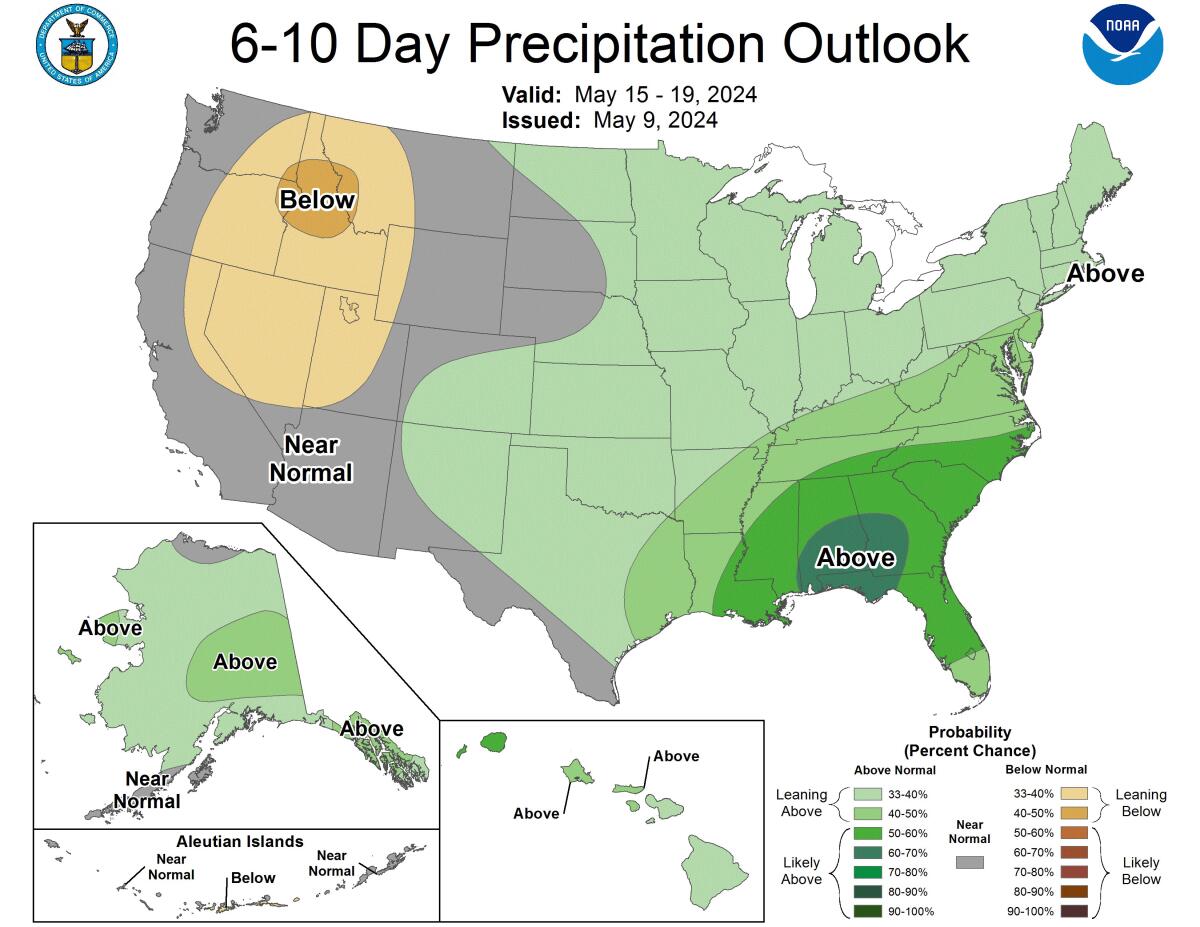After one other wet winter that dragged into springtime, California is lastly transferring towards a hotter and drier sample, with temperatures anticipated to hit typical highs — or above — for this time of yr.
“It’s feeling form of spring [or] summery,” stated Rose Schoenfeld, a Nationwide Climate Service meteorologist in Oxnard. “We don’t have any rain in our forecast arising.”
It’s a welcome change for a lot of after a number of spring weekends dampened by storm programs that introduced rain, dreary skies and funky temperatures.
Within the Los Angeles space, temperatures are anticipated to rise — very regularly — by means of Sunday, with the best temperatures coming to the inside valleys. The Antelope Valley may attain into the 90s Sunday, whereas the remainder of the world’s valleys are forecast to peak within the higher 80s.
In downtown L.A., anticipate temperatures within the low 80s.
The six- to 10-day temperature outlook from the Nationwide Oceanic and Atmospheric Administration, issued Could 9 and legitimate from Could 15 to 19.
(NOAA)
Within the Central and Sacramento valleys, a extra drastic warming trend is predicted to proceed by means of early subsequent week, when highs are anticipated to hit the mid-90s throughout inland California. Highs may attain 10 levels above regular by Sunday for a lot of the Central Valley — with highs forecast to hit 94 in Bakersfield and Fresno.
The Bay Space can also be anticipated to maintain warming quickly, after a 20-degree jump recorded Thursday, pushed by dry offshore winds. Even larger temperatures are anticipated Friday.
The state’s longer-range forecasts present these above-average temperatures sticking round at the least by means of late Could, in accordance with the most recent Local weather Prediction Middle’s outlook maps. And the long-range precipitation forecast — from Could 15 to 23 — reveals many of the state remaining at near normal rainfall, which for Could means restricted to no precipitation, particularly in Southern California.
However these shifts are so gradual — and observe such important rain and snowfall — that officers are nonetheless anticipating a delayed start to wildfire season. The season can typically begin as early as April or Could in some dry years, however specialists say late spring storms and a still-strong snowpack have saved crops from drying out.
“After a reasonably good quantity of later-season storms … we’re at the moment on observe for a later-onset hearth season than some years,” Schoenfeld stated.
That’s no purpose to not take precautions, she stated, as a growth in brush and grass development from heavy rains can present harmful gas for fires as soon as the crops have dried out. Already this previous week, Riverside County noticed two comparatively small brush fires.
“It’s greatest to all the time be ready, and one thing like an enormous Santa Ana [wind] occasion would put us proper into hearth season,” Schoenfeld stated. “Even when it’s a bit of bit later than regular, hearth season is coming.”

The six- to 10-day precipitation outlook from the Nationwide Oceanic and Atmospheric Administration, issued Could 9 and legitimate from Could 15 to 19.
(NOAA)
A late begin to wildfires, nevertheless, might imply a harmful mid- to late season this yr, stated Daniel Swain, a UCLA climatologist.
“I believe this yr is a yr we’ll have a sluggish begin, however a very pronounced and maybe intense end — and one which maybe lasts longer than typical,” Swain stated, talking recently about climate trends for this summer. “We might genuinely have an unusually sluggish begin and an unusually intense end in elements of California.”
He expects that by the point the state dries up — possible into August and September — any warmth wave may create worrisome situations, particularly for a state that has seen large underbrush development after two moist years.
“We’ve seen loads of vegetation development and never loads of hearth exercise,” he stated. “What this implies is, there’s now a a lot larger unburned biomass than there was through the drought.”








